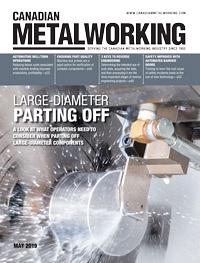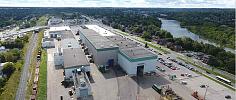vice-president of sales and marketing
- FMA
- The Fabricator
- FABTECH
- Canadian Metalworking
Ensuring part quality
Machine tool probes are a good option for verification of complex components
- By Philip Smith
- May 29, 2019
- Article
- Measurement

It’s important for a shop to make sure the part is right throughout the process and not experience the pain of "gotcha" moments after the machining process. A lot of feature verification can be done on the machine with the probe.
Machine shops are always looking for ways to reduce cycle time. Using a probe to measure parts can translate into increased cycle time, cutting away valuable machining time. This sentiment can cause shops to view probing as a challenge to overall operability. However, it is important to remember that cycle time isn’t just about the amount of time it takes to make a part, it’s also about the amount of time it takes to make a good part, and probing is an essential part of the process.
A shop that limits probing in favor of decreased cycle time might gain efficiencies, but it could result in just being really good at making scrap parts. If a shop is looking to make good parts, it is fundamental to understand how the machine tool is performing; probing can help in this regard.
MACHINE CAPABILITY
One of the most important aspects of creating good parts is ensuring that the machine tool is capable of performing tasks and operations to meet project requirements. Sometimes shops think that putting a probe on an older machine tool, one that has never undergone preventive maintenance or service work, will ensure it produces a perfect part. That’s not the case. Adding a probe will help identify errors and flaws within the machine tool. However, if the machine is incapable of meeting project requirements, then the shop has wasted its money on all this extra equipment.
Before even thinking about adding processes like in-machine probing, shops need to assess the machine tool capabilities, find the best option for a given project, and then explore quality control options.
COMPLEX COMPONENT VERIFICATION
Machining high-value, complex components requires additional quality control steps to ensure parts are produced correctly. The last thing a shop wants to see is an expensive part making it all the way to the quality control department before realizing it is out of spec and needs to be reworked or even scrapped.
There is a need for traditional standards rooms when it comes to producing complex prismatic parts, particularly in the aerospace sector where safety-critical components are produced. A quality control room with a coordinate measuring machine (CMM) is essential for shops to determine references and standards. However, the last thing an operator wants is to get a part to the CMM and find out it’s wrong. At that point it’s all a bit too late. It also doesn’t necessarily determine at what point in the process the error occurred. It could have been a feature that was machined early in the process and all the additional machining time beyond that feature was for naught. Sometimes components can be put back on the machine to be reworked, but that can be an incredibly difficult process, especially if it is a complex component.
In these cases, it’s important for a shop to make sure the part is right throughout the process and not experience the pain of "gotcha" moments after the machining process. A lot of feature verification can be done on the machine with the probe before the part gets to the CMM or this stage of the process.
When it comes to large parts, for instance large weldments, probing on the machine is generally the best option, especially where cycle times are less important.
MACHINE PERFORMANCE
Yes, even some of the best machine shops have crashes and collisions on their machine tools! It is important to the overall machining process that the machine is performing correctly, and a crash or collision can fundamentally affect the effectiveness of the machine tool.
Running simple tests can help create a baseline for machine performance. Some shops set a schedule for machine performance testing and can compare current tests with ones that have proven in spec. Having a performance history is a great way to assess the machine’s status. It also helps after a crash. Sometimes the crash can sound terrible but really didn’t do any damage to the machine. After a quick assessment, the operator can continue with the project with no worry of part failure.

A ballbar system is an economical option so even small shops can invest in this machine performance test equipment. However, it is also a great choice for high-value, complex part producers.
Some tools on the market can help a machinist or shop manager establish how the machine is performing pre- and postcrash as well as in day-to-day operations.
BALLBAR SYSTEMS
One such tool is a ballbar system. These devices provide a simple, rapid comparison of a CNC machine tool’s positioning performance against recognized international standards. This allows an operator to benchmark and track the performance of the machines, quickly diagnose problems that may require maintenance, and pinpoint the error sources that produce them.
A ballbar system is an economical option, so even small shops can invest in this machine performance test equipment. However, it is also a great choice for high value, complex part producers like aerospace manufacturers that may want to quickly check the machine throughout the process of machining an engine component or landing gear.
5-AXIS MACHINING PROBES
For shops that do a lot of 5-axis machining, a number of probes are available designed specifically for use on these machines. These devices are called strain gauge probes and are incredibly repeatable devices. Under the right circumstances, they will repeat to 0.25 μm.
Over the past few years, as more and more machine shops get into 5-axis machining and prismatic parts and parts with freeform surfaces, in-machine probing, particularly with strain gauge probes, is becoming increasingly popular.
With 5-axis machining it is important to understand pivot points or axis of rotation. These machines have two axes that rotate around one another, often the A axis and C axis, and to machine correctly it is essential to know where the pivot point or axis of rotation is with respect to each other. If it is unknown or there is an error, that error will become part of the component. Using an on-machine probe will help the operator identify if there is an error, which he or she can then compensate for.
Most 5-axis machines come factory equipped with a machine probe. However, not all machine probes are suitable for complex, hard-to-reach features. Therefore, it is recommended that shops explore what probing options they may need to verify parts as early as they can before starting a project.
Using a probe with a long and possibly custom stylus configuration allows a shop to measure difficult-to-reach features accurately and efficiently. This needs to be considered when choosing a machine tool probe. For extremely complex parts, often found in the aerospace industry, multiple machine tool probes can be used, each having a different stylus configuration designed for each unique feature verification.
PROBE TECHNOLOGY
Beyond standard (kinematic) and strain gauge probes, analog scanning probes are one of the latest developments in the probing world. Particularly designed for use on the machine tool, these scanning probes can very quickly scan a part and collect a large amount of data about that part. They can determine component size, feature size, positioning, form, surface waviness, and even surface finish. These are all component criteria that are becoming increasingly important to verify.
These niche devices can be very expensive, but in industries like aerospace that are creating costly and complex parts, they offer great advantage to the manufacturer. As the technology advances, analog scanning probes will become more accessible for shops that require this level of detailed data.

Not all machine probes are suitable for complex, hard-to-reach features. It is important for a shop to explore probing options as early as possible before starting a project.
It’s really all about getting the most component feature data in the quickest amount of time. That’s where on-machine probing is going. Operators want to go as fast as possible, but it is critical to maintain accuracy and repeatability throughout the entire process. Without maintaining these, there is little point to probing or component feature verification because the values are incorrect.
Philip Smith is vice-president of sales and marketing for Renishaw Canada, 2196 Dunwin Dr., Mississauga, Ont. L5L 1C7, 905-828-0104, www.renishaw.com.
About the Author
Related Companies
subscribe now


Keep up to date with the latest news, events, and technology for all things metal from our pair of monthly magazines written specifically for Canadian manufacturers!
Start Your Free Subscription- Industry Events
MME Saskatoon
- May 28, 2024
- Saskatoon, SK Canada
CME's Health & Safety Symposium for Manufacturers
- May 29, 2024
- Mississauga, ON Canada
DiPaolo Machine Tools Open House 2024
- June 4 - 5, 2024
- Mississauga, ON Canada
FABTECH Canada
- June 11 - 13, 2024
- Toronto, ON Canada
Zoller Open House & Technology Days 2024
- June 12 - 13, 2024
- Ann Arbor, MI




















